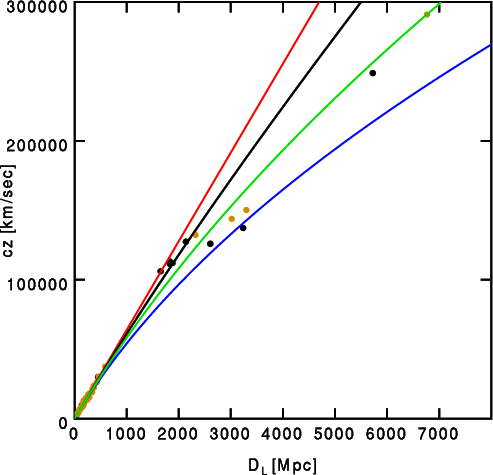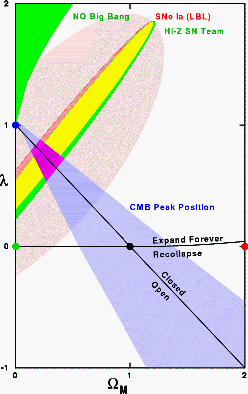
Two groups are measuring distant supernovae with the goal of determining whether the Universe is open or closed by measuring the curvature in the Hubble diagram. The figure below shows both data sets: Perlmutter et al. (1997) and (1998) in black and Garnavich et al. (1997) in orange.

The curves show a closed Universe (Omega = 2) in red, the critical density Universe (Omega = 1) in black, the empty Universe (Omega = 0) in green, and the steady state model in blue. The supernova luminosity calibration used to compute the luminosity distance DL is from Riess, Press and Kirshner (1996) which gives Ho = 65 km/sec/Mpc. The data show a larger scatter than that expected based on the accuracy of the low redshift sample, but Omega appears to be in the range 0 to 1.
 Both groups have been the subject of news articles in Science, on 30 Jan
1998 and 27 Feb 1998. I have combined their two error ellipses along
with another constraint from the location of the Doppler peak in the
angular power spectrum of the CMB anisotropy. The two SNe groups give
very similar error ellipses, and the combined CMB-SNe fit indicates that
a flat Universe with a
cosmological constant is preferred. But the
systematic errors on the SNe data, shown as the large grey (or pink) ellipse,
could allow for a vanishing cosmological constant lambda.
The red, black, green and blue circles on the Figure to the right are
keyed to the colors of the curves on the Figure shown above.
A larger GIF file or a
Postscript version of this figure are
available.
Both groups have been the subject of news articles in Science, on 30 Jan
1998 and 27 Feb 1998. I have combined their two error ellipses along
with another constraint from the location of the Doppler peak in the
angular power spectrum of the CMB anisotropy. The two SNe groups give
very similar error ellipses, and the combined CMB-SNe fit indicates that
a flat Universe with a
cosmological constant is preferred. But the
systematic errors on the SNe data, shown as the large grey (or pink) ellipse,
could allow for a vanishing cosmological constant lambda.
The red, black, green and blue circles on the Figure to the right are
keyed to the colors of the curves on the Figure shown above.
A larger GIF file or a
Postscript version of this figure are
available.
FAQ | Tutorial : Part 1 | Part 2 | Part 3 | Part 4 | Age | Distances | Bibliography | Relativity
© 1997-1998 Edward L. Wright. Last modified 8-Apr-1998